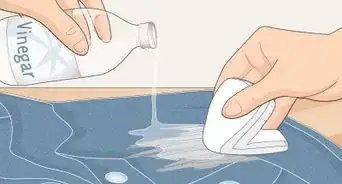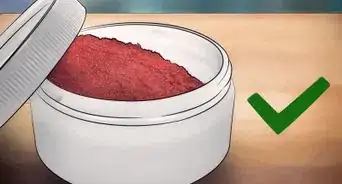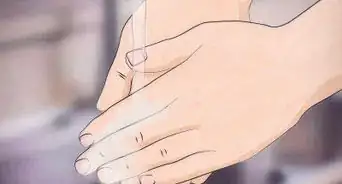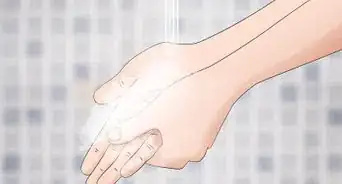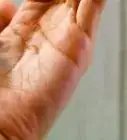wikiHow is a “wiki,” similar to Wikipedia, which means that many of our articles are co-written by multiple authors. To create this article, 34 people, some anonymous, worked to edit and improve it over time.
wikiHow marks an article as reader-approved once it receives enough positive feedback. This article has 14 testimonials from our readers, earning it our reader-approved status.
This article has been viewed 646,685 times.
Learn more...
Silicone caulk can be a great tool for home improvement projects like filling cracks in the exterior of a house or waterproofing a shed in your backyard. Its stickiness and gap-filling properties make it an excellent watertight sealant. Unfortunately, these same properties can make it a serious pain to get off of your hands when you're done working. Because the quickest, easiest way to spread caulk is often with your fingers, this can become a frequent nuisance during large-scale projects. To learn how to get this sticky substance off of your hands with a minimum of time and effort, get started with Step 1 below!
Steps
Removing Wet Caulk with Plastic
-
1Remove as much of the caulk as you can before it dries. Silicone caulk can be seriously sticky stuff, so the more you can get off of your hands initially, the easier it will be to get your hands completely clean in the long run. As soon as you notice caulk on your hands, take a tissue or paper towel and immediately wipe it away. Discard the tissue or paper towel immediately afterward to avoid accidentally spreading the caulk.
- Don't use a fabric towel (especially one that you care about). Once silicone dries, it's very difficult to get out. In addition, it's basically waterproof, so even if it doesn't ruin your towel's appearance, it may make it less useful as a towel.
-
2Rub your hands with a plastic bag. Once you wipe the excess caulk off of your hands, grab a cheap plastic bag (like the kind you get at the grocery store). Rub your hands with the bag, using it the same way you'd use a washcloth. If the silicone hasn't already dried, it should cling to the bag more readily than it clings to your hands, removing much of the remaining caulk. Though this trick is a little unconventional, it's cited by certain home improvement resources as being effective.
- If you don't have a grocery bag handy, most cheap plastic bags (like, for instance, trash can liners) should work well.
Advertisement -
3Rinse with water. If the caulk on your hands hasn't had a chance to dry, you should be able to remove much of it with a paper towel or plastic bag. To get the last of it, rinse with water.[1] As you rinse, periodically scrub your hands with a sponge, paper towel, or mild abrasive. As noted above, you'll probably want to avoid using "nice" towels to remove caulk.
- You may use soap if you wish. However, it's unclear whether doing this has any significant effect.
-
4Dry your hands and repeat if needed. Next, dry your hands off with a rag or paper towel. Examine them carefully, checking for any remaining caulk. Be thorough — even a small amount can be annoying once it dries. If you see any silicone remaining, you will probably want to repeat the steps above as needed until it's been removed or it's become obvious that it won't leave your hands.
-
5Act fast! When used for its intended purpose, silicone caulk can take some time to dry completely — roughly 24 hours for a standard "bead". However, when it's spread thin or in tiny drops on your hands, it can dry much faster. Because of this, time is of the essence when you're trying to get silicone caulk off of your hands. The quicker you start removing wet caulk from your hands, the less effort you'll have to spend trying to remove dry caulk, which is much harder to clean off.
- Because a big part of keeping your hands clean when caulking is to be able to clean them right away, it can be very helpful to keep cleaning supplies with you as you do your caulking. Keeping a clean plastic bag and a few paper towels near you while you work can make the difference between completely clean hands at the end of your project and the lingering inconvenience of hands caked with dry silicone.
-
6Try using a home remedy if dry caulk remains. If you've tried the tips above and haven't been able to get the caulk off of your hands, there's a good chance that it's had time to dry. Unfortunately, because dry caulk is a strong adhesive and is basically waterproof, paper towels, plastic bags, and water won't be much help removing it. In this case, you may want to try one of the many home remedies recommended for removing dried caulk from your hands in the section below. Though these methods aren't definitively proven, many online sources recommend them.
Removing Dry Caulk with a Home Remedy
-
1Try acetone. One of the most common pieces of advice you may find online when trying to remove dried silicone from your hands is to use acetone. Acetone, an organic chemical frequently used in nail polish removers, is able to dissolve some plastics (like, for instance, acrylic nail polish) with ease. Its ability to dissolve or weaken silicone caulk is less definite. However, many online sources attest to its usefulness.
- To use this method, soak the corner of a paper towel with pure acetone or a nail polish remover containing acetone and gently wet the spots on your hands covered with acetone. Don't pour the acetone all over your hands — this is wasteful and can produce noxious unpleasant fumes. If using nail polish remover, check the ingredient label to be sure it contains acetone before using.
-
2Try (cautiously) using a hair dryer. Silicone, like many other synthetic compounds, will eventually weaken if heated up gradually. Because of this property, some sources recommend using a hair dryer to loosen the caulk's hold on your hands. Turn the dryer on and wave it over the affected areas, allowing the silicone to gradually warm. Once you feel that the silicone has heated up, try scrubbing with a sponge or another mild abrasive to get it off.
- If you want to try this method, be sure to start with the lowest possible setting on the hair dryer. Gradually increase the heat as needed and stop immediately if the heat becomes intense or painful. Silicone isn't worth burning yourself over — it will eventually fall off on its own.
-
3Try an abrasive. Another way to get silicone off of your hands is simply to rub (and rub, and rub...) until there's none left. However, this method requires a warning. Silicone is quite tough — in fact, for most purposes, it's tougher than your skin. Because of this, you'll want to be very careful as you use your abrasive to remove the silicone to avoid rubbing your skin raw. Use only mild abrasives, not harsh ones like steel wool. Stop rubbing well before you think you might be sore. Remember, the silicone will eventually fall off on its own, so there's no reason to hurt yourself trying to get it off. Just a few appropriate abrasives you might consider using are:
- Kitchen sponges
- Fine-grit sandpaper (if you're careful)
- Pumice stones
-
4Try mineral spirits. Like acetone, mineral spirits (a turpentine substitute sometimes called "white spirits" in the UK) are sometimes prescribed for the task of weakening stubborn silicone caulk. As with acetone, the actual usefulness of mineral spirits is the subject of some doubt, though some home improvement sites recommend them. If you have some mineral spirits handy, try applying some to dried-on silicone lightly with a soaked paper towel. Follow with abrasion once the spirits have had a chance to weaken the silicone. If you don't have mineral spirits, you can usually find some at major hardware stores for fairly cheap (usually not much more than $10 per gallon).
- While mineral spirits are usually not dangerous to touch, be sure to thoroughly wash yourself after coming into contact with them. Being in direct contact with mineral spirits for several hours or longer can lead to seriously nasty chemical burns.[2]
-
5When all else fails, simply wait. Sometimes, particularly stubborn spots of silicone caulk can stick to your hands despite your repeated efforts to get it off. In these cases, your best option may be simply to wait for it to fall off on its own, rather than wear your hands red trying to get it off. Your body naturally sheds dead skin cells nearly constantly. Once the skin under the dried-on silicone dies, it will eventually fall off, taking the caulk with it.
- The human body usually takes about 27 days to completely shed and replenish an entire layer of skin.[3] The silicon gel dried to your hands will probably take less time to fall off (on the order of a week or so).
-
6Don't use harsh solvents. When it comes to getting silicone caulk off of your hands, stick to the safe methods described in this article — don't risk trying anything that may hurt you. For instance, while acetone and mineral spirits are generally safe for brief use on your hands, other, harsher chemicals can present serious problems. Many noxious or caustic solvents can be harmful if touched, inhaled, or ingested, so you'll want to stay far away from them. Below are just a few of the sorts of chemicals you definitely won't want to use to get caulk off of your hands:
- Bleach
- Drain cleaner
- Paint thinner
- Lye
- Strong acids or bases.
-
7Don't scrape or gouge the caulk. Never use a sharp tool or a harsh abrasive to physically remove silicone caulk from your hands. Though it may be tempting to use a knife or a handful of steel wool to scrape or cut annoying dried-on caulk away from your hands, these methods run a high risk of injuring your hands. On top of this, there's very little guarantee that they work well against the gummy, clingy texture of silicone. Though this advice probably goes without saying for most, in the interests of safety, it bears mentioning.
Warnings
- Though it might seem like it goes without saying, you'll never want to use your mouth to get caulk off of your hands. Almost every type of caulk used for home improvement projects — including silicone caulk — can be toxic if ingested.[4]⧼thumbs_response⧽
Things You'll Need
- Plastic bag
- Water
- Nail polish remover
References
About This Article
To remove dried silicone caulk from your hands, start by soaking a paper towel in acetone or nail polish remover. Then, gently dab the acetone on spots that are covered in caulk and try to wipe it away. If that doesn’t work, try warming the silicone with a hair dryer on the lowest setting to weaken the plastic in the caulk. Then, use a pumice stone to rub it away. Read on for tips on removing caulk from your hands while it’s still wet!

